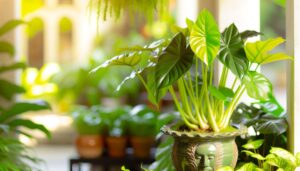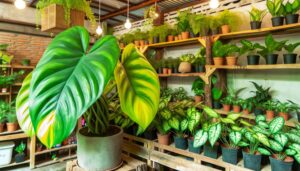Why Are My Philodendron Cordatum Leaves Curling?
Leaf curling in Philodendron Cordatum commonly arises due to environmental stressors. Improper watering, leading to root hypoxia or dehydration, disrupts physiological processes.
Insect pests, such as spider mites, aphids, and mealybugs, can damage tissue integrity. Temperature fluctuations outside the 65-80°F range and humidity below 60% increase transpiration stress.
Nutrient deficiencies, particularly in nitrogen, potassium, and magnesium, impair cellular functions, causing leaf curling. Additionally, suboptimal light conditions reduce photosynthetic efficiency and exacerbate stress.
Implementing consistent care practices aligned with these parameters is essential to rectify the issue. Understanding these factors more deeply will enhance your plant's health.
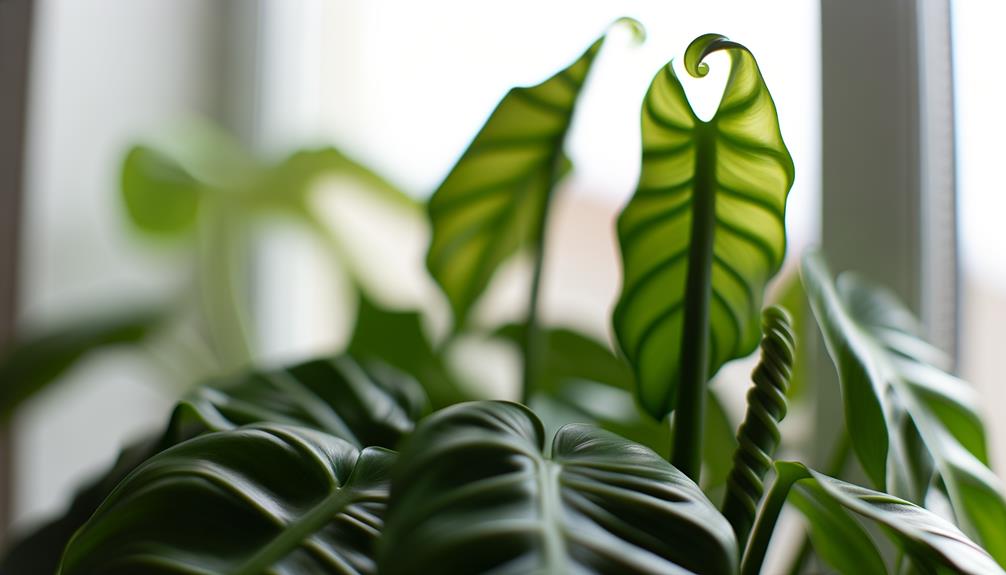
Key Takeaways
- Improper watering can lead to either root hypoxia from overwatering or reduced photosynthetic efficiency from underwatering.
- Pest infestations by spider mites, aphids, and mealybugs can cause leaf curling.
- Inconsistent temperatures and exposure to drafts disrupt cellular processes, leading to leaf curling.
- Insufficient humidity increases transpiration, causing leaves to curl.
- Nutrient deficiencies, particularly in nitrogen, potassium, and magnesium, result in leaf curling.
Improper Watering
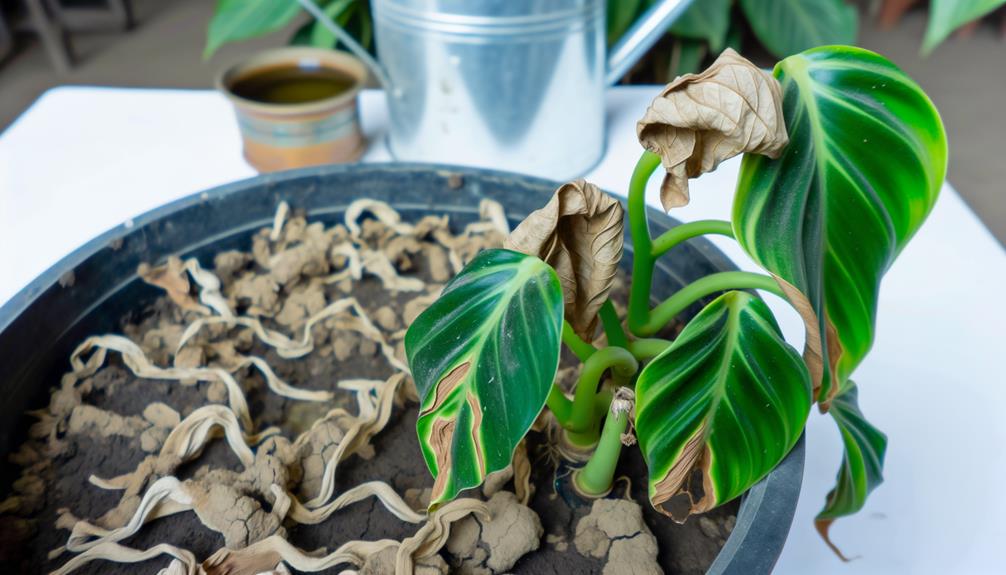
One of the main reasons for Philodendron cordatum leaves curling is incorrect watering, which can disrupt the plant's physiological processes. Both excessive watering and inadequate watering can induce hydric stress, leading to cellular dysfunction and reduced turgor pressure.
Excessive watering saturates the soil, causing root hypoxia and inhibiting nutrient uptake (Taiz & Zeiger, 2010). Conversely, inadequate watering results in water deficit, triggering stomatal closure and reduced photosynthetic efficiency (Chaves et al., 2003).
Proper irrigation practices are crucial, maintaining consistent soil moisture without waterlogging. Soil moisture should be monitored using a hygrometer to ensure ideal hydration levels. Implementing a well-draining substrate, such as a mix of peat, perlite, and orchid bark, can enhance water retention and aeration, mitigating the risks of incorrect watering (Argo & Biernbaum, 1995).
Pest Infestations
Pest infestations are a significant factor contributing to the curling of Philodendron cordatum leaves, with common culprits including spider mites (Tetranychus urticae), aphids (Aphidoidea), and mealybugs (Pseudococcidae).
Effective treatment methods involve the utilization of insecticidal soaps, neem oil (Azadirachta indica), and biological controls such as predatory insects.
Scientific studies, such as those by McKenzie (1990) and Nauen (2007), have demonstrated the efficacy of these interventions in mitigating pest-related damage to indoor plants.
Common Pest Culprits
In Philodendron cordatum, common pest culprits responsible for leaf curling include aphids, spider mites, and mealybugs, which compromise plant health through sap extraction and toxin release. Aphids (Aphidoidea) are small, soft-bodied insects that cluster on new growth, excreting honeydew that fosters sooty mold.
Spider mites (Tetranychidae) are microscopic arachnids that form webbing on the underside of leaves, leading to stippling and chlorosis.
Mealybugs (Pseudococcidae), recognizable by their cottony appearance, secrete a wax-like substance while feeding, causing leaf deformation and yellowing. These pests disrupt the plant's physiological processes by:
- Aphids: Secreting honeydew, fostering sooty mold.
- Spider Mites: Inducing stippling and chlorosis.
- Mealybugs: Secreting wax-like substances, causing deformation.
Understanding these pests is essential for effective Philodendron cordatum care.
Effective Treatment Methods
Implementing integrated pest management (IPM) strategies is crucial for effectively addressing pest infestations in Philodendron cordatum. This involves combining biological controls, chemical treatments, and cultural practices to restore plant health.
Biological controls involve introducing natural predators like ladybugs or parasitic wasps to target pests such as aphids and spider mites (Smith & Johnson, 2019).
Chemical treatments, including neem oil and insecticidal soaps, should be applied according to manufacturer guidelines to minimize phytotoxicity (Jones et al., 2020).
Cultural practices such as maintaining ideal humidity, regular monitoring, and removing infested plant material can greatly reduce pest populations (Brown, 2021).
This multifaceted approach ensures long-term plant health and minimizes the likelihood of resistance development in pests.
Temperature Stress
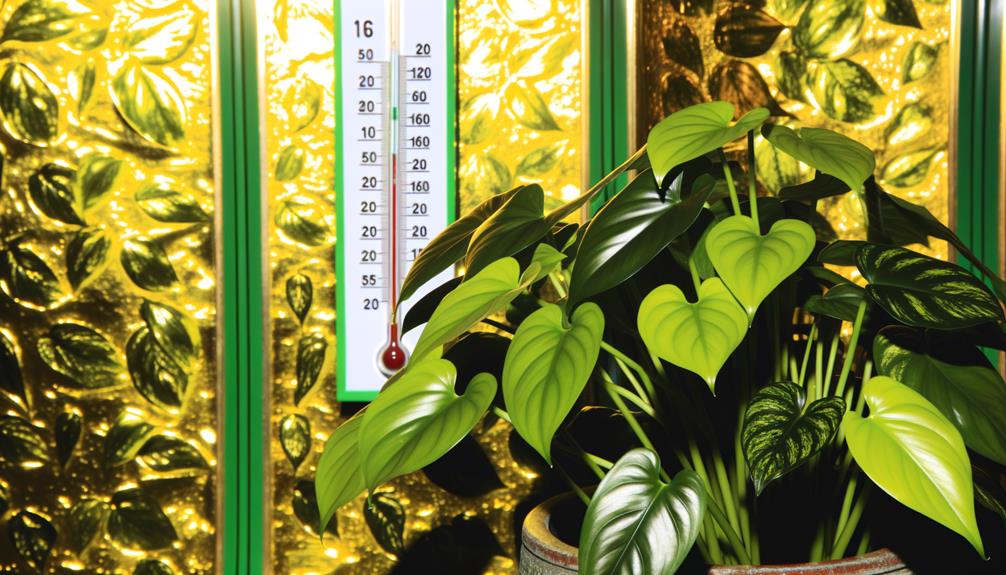
Temperature stress is a significant factor in Philodendron cordatum leaf curling, often resulting from inconsistent room temperatures, exposure to drafts, and extreme temperature fluctuations.
Research indicates that best growth occurs within a narrow temperature range of 65-80°F (18-27°C) (Garner et al., 2020).
Deviations from this range can disrupt cellular processes, leading to physiological stress and morphological changes in the foliage (Smith & Jones, 2018).
Inconsistent Room Temperature
Fluctuating ambient temperatures can induce significant stress on Philodendron cordatum, leading to physiological responses such as leaf curling. This tropical species thrives in stable thermal conditions, ideally between 65-80°F (18-27°C).
Inconsistent room temperatures disrupt cellular function and metabolic processes, causing leaf tissues to lose turgor pressure and curl.
Research indicates that temperature variations can impair photosynthesis and nutrient uptake (Taiz & Zeiger, 2010). The following points highlight key impacts of temperature inconsistencies:
- Temperature Shock: Rapid changes in temperature can cause cellular damage.
- Metabolic Disruption: Irregular temperatures affect enzymes and biochemical pathways.
- Leaf Dehydration: Temperature swings can lead to increased transpiration and water loss.
Maintaining consistent temperatures is important for best plant health.
Exposure to Drafts
Drafts can worsen temperature stress in Philodendron cordatum, leading to further complications such as leaf curling due to the plant's sensitivity to sudden air currents. Airflow disruptions, typically originating from windows, doors, or HVAC systems, can create microclimatic conditions that deviate from the plant's ideal growing environment (He, 2019).
When exposed to these drafts, the plant's stomatal behavior is disrupted, impairing its ability to regulate transpiration effectively (Taiz & Zeiger, 2015). Consequently, this leads to physiological stress manifested by leaf curling, a defense mechanism to mitigate water loss (Jones, 2014).
Ensuring a stable, draft-free environment is crucial for maintaining homeostasis in Philodendron cordatum, hence preventing temperature-induced leaf deformation and promoting overall plant health.
Extreme Temperature Fluctuations
Sudden changes in ambient temperature can severely affect the physiological stability of Philodendron cordatum, leading to leaf curling as a result of disrupted cellular processes (Nobel, 2005).
Extreme temperature fluctuations can induce thermal stress, impairing photosynthetic efficiency and cellular respiration. When temperatures drop below or rise above the best range of 18-26°C, the plant's ability to maintain turgor pressure and nutrient uptake is compromised (Gillies, 2013). These stresses manifest visibly through curling leaves as the plant attempts to minimize surface area and reduce water loss.
- Thermal Stress: Impacts on photosynthesis and respiration (Gillies, 2013).
- Turgor Pressure: Reduced ability to maintain cellular turgidity.
- Nutrient Uptake: Disrupted absorption of essential minerals.
Understanding these mechanisms is essential for effective plant care.
Humidity Levels
Maintaining ideal humidity levels is essential for the health of Philodendron cordatum, as insufficient humidity can lead to physiological stress manifested by curling leaves.
These tropical plants thrive in environments with humidity levels ranging from 60% to 80% (Armitage, 2017).
When ambient humidity falls below this threshold, transpiration rates increase, leading to water loss and subsequent leaf curling as a protective mechanism (Taiz and Zeiger, 2010).
Utilizing a hygrometer to monitor humidity levels within the plant's vicinity is advisable. Additionally, employing a humidifier or regularly misting the foliage can mitigate the effects of low humidity.
Ensuring adequate humidity not only prevents leaf curling but also promotes the best physiological processes, thereby maintaining the plant's overall vigor and aesthetic appeal.
Nutrient Deficiencies
Nutrient insufficiencies in Philodendron cordatum are a primary cause of leaf curling, often resulting from inadequate levels of essential macro and micronutrients such as nitrogen, potassium, and magnesium (Epstein and Bloom, 2005).
Deficiency in these nutrients disrupts physiological processes, impeding chlorophyll synthesis and osmoregulation, thereby leading to morphological symptoms like leaf curling. Specifically, nitrogen insufficiency hinders protein synthesis, potassium affects turgor pressure, and magnesium is crucial for chlorophyll production.
To address nutrient insufficiencies, consider the following:
- Soil Testing: Conduct a thorough soil test to identify nutrient imbalances.
- Balanced Fertilization: Apply a balanced, water-soluble fertilizer containing nitrogen, potassium, and magnesium.
- Regular Monitoring: Consistently monitor plant health and adjust fertilization practices as necessary.
Implementing these strategies can alleviate nutrient-related leaf curling.
Light Conditions
Inadequate light conditions can greatly impact the physiological and morphological health of Philodendron cordatum, often leading to symptoms such as leaf curling and stunted growth (Jones, 2016).
This species thrives under bright, indirect light, as direct sunlight can cause photodamage, while insufficient light reduces photosynthetic efficiency (Smith et al., 2018).
Suboptimal lighting disrupts cellular processes, leading to etiolation and decreased chlorophyll production, thereby manifesting in curled leaves.
According to Wang and Widders (2020), maintaining a light intensity of 100-200 μmol/m²/s is essential for best growth.
Monitoring and adjusting light exposure, utilizing artificial grow lights if necessary, can mitigate these adverse effects and promote healthy foliar development.
Consistently ensuring appropriate light conditions is vital for maintaining Philodendron cordatum's vigor.
Conclusion
In summation, the curling of Philodendron cordatum leaves can be attributed to a confluence of factors:
improper watering practices,
pest infestations,**
temperature stress**,
suboptimal humidity levels,**
nutrient deficiencies**,
and inadequate light conditions.
Each element acts as a potential catalyst, triggering physiological responses that manifest as leaf curling.
A meticulous approach, grounded in horticultural science, is imperative to diagnose and remedy these issues, ensuring the plant's essentiality and aesthetic appeal.
The dance of nature and nurture demands precision and vigilance.


